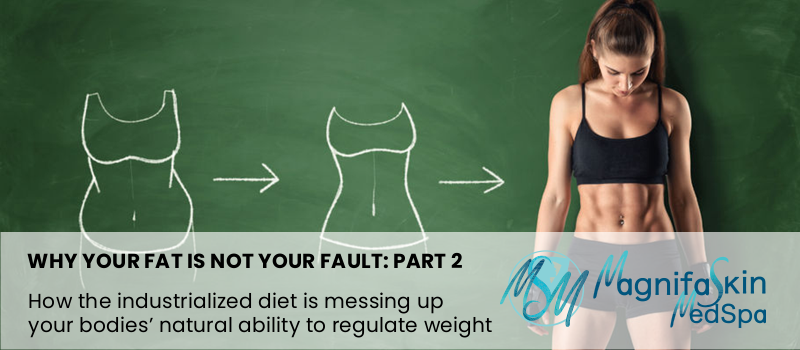
Why Your Fat Is Not Your Fault: Part 2
In this post, we’ll continue from my last article on sugar, and how hidden (and ‘not so hidden’) sugar consumption is not only poisoning us, but setting us up to fail to achieve our body image goals and maintain good health. I believe strongly that most people fail to achieve those goals due to a lack of knowledge, and not due to a lack of self-discipline as is commonly believed. Education is the key to reversing the global obesity epidemic (better described as Chronic Metabolic Syndrome), and helping individuals to become not only happy with their weight, but more importantly, healthy.
The Negative Feedback Loop
Last week, I referred to how sugar consumption causes a negative feedback loop in our bodies that makes us eat more and move less. In this post, we’re going to see exactly how that happens.
The Fat Storage Hormone
Insulin. Everybody has heard of it. We know insulin is made in our pancreas and controls our blood sugar. What you may not know is that high levels of insulin prompt our body to store fat. Today, the average American is consuming about four times the recommended amount of sugar. It’s not just in sugary drinks and treats. The processed food industry has added sugar in vast quantities to our food supply. They’ve done this because removing fat causes food to lose flavor. The result is that sugar can be found in 80% of the foods on our grocery store shelves. You might be shocked to discover that even supposedly healthy foods like whole grain bread and yogurt contain large amounts of added sugar.
Add to this the fact that foods made with refined grains (flour) also elevate our blood sugar. These foods have a high glycemic index. That means our body digests them quickly, resulting in high levels of glucose being released into our bloodstream. Between the added sugars and the high-glycemic-index processed foods, most of us have highly elevated insulin levels pretty much 24/7. While I’m not going to get into exactly how insulin causes us to store fat, these high insulin levels combined with sugary foods, prompt our bodies to not only store fat, but to do so very rapidly under the right conditions. This is why a single session of binge eating can undo days of dietary discipline.
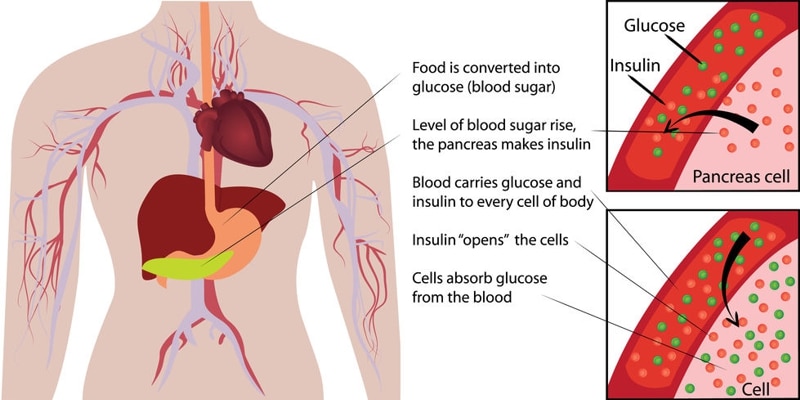
When blood sugar (glucose) rises, our pancreas releases more insulin, which allows our cells to absorb the glucose where it is burned by the mitochondria for energy. The higher our insulin level, the higher the percentage of the food we ate will be stored as fat.
But It Gets Worse!
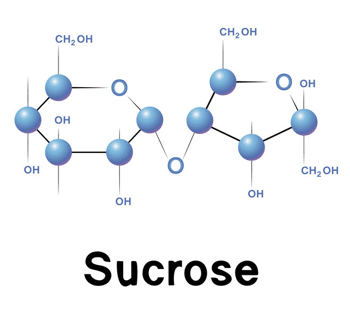
Sucrose, or table sugar, has one glucose and one fructose molecule. They are joined by a bond which is almost instantantly broken by the enzyme glucase when it enters our stomach. While table sugar is 50% fructose, some high fructose corn syrups are as high as 65% fructose.
What is sugar? Table sugar, or sucrose, is a molecule that is made up of one glucose molecule, and one fructose molecule. Glucose is the stuff our cells burn for energy, and most of us know that fructose is fruit sugar. Glucose isn’t actually sweet, but fructose is very sweet. This is why the food industry has moved toward using a lot of high fructose corn syrup. It’s sweet and very cheap to produce. Unfortunately, all that fructose in our diet is toxic. Literally toxic, in much the same way that alcohol is.
Fructose. It’s Poisoning You.
So how can a sugar that occurs naturally in fruit be bad for us, and what does it have to do with controlling our weight?
We all know that alcohol is bad for us if we have too much, but harmless as long as we drink in moderation. Alcohol is what is known as a ‘threshold toxin’. A little won’t hurt you, but a lot will. And a lot of it consumed regularly will eventually kill you.
Fructose is also a threshold toxin. A little is harmless. Our body can metabolize it in our liver, however, only by turning it into fat. This is true of alcohol too, by the way. However, a lot of fructose, consumed daily, causes something called ‘non-alcoholic fatty liver disease’. NAFLD is really the same thing as the fatty liver disease developed by alcoholics, only the cause is different. Fat builds up in the liver to the point where the liver no longer works properly. This is caused largely by the fact that our body can’t use fructose for energy. All it can do with it is turn it into fat. And remember, most of us are consuming toxic levels of fructose – about 4 times the safe limit. And all that fructose gets turned into fat!
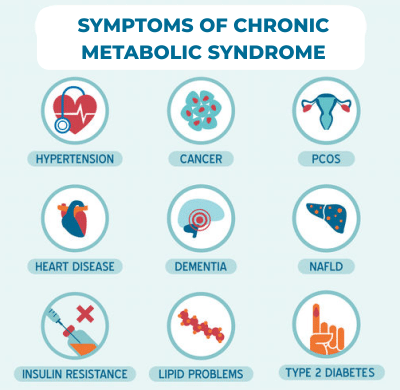
While this graphic does indeed list most of the symptoms of Chronic Metabolic Syndrome, it also serves to show a very common misconception. Obesity is not listed because it is seen as the disease. Obesity is also a symptom.
Chronic Metabolic Syndrome
Non-Alcoholic Fatty Liver Disease has certain very common symptoms. Obesity is one. In addition, those suffering from non-alcoholic fatty liver disease are also prone to developing hypertension (high blood pressure), heart disease, high cholesterol, hardening of the arteries, and diabetes. If you have any three of these, you almost certainly have a fatty liver, and are suffering from something called Chronic Metabolic Syndrome.
CMS is a fancy way of saying your metabolism is permanently out of whack. But how does that lead to obesity? Now we’re getting down to the heart of the problem, and why your fat is not your fault.
An Important Side Note About Obesity
Notice that obesity is a symptom of NAFLD. It is not the disease! This is why 40% of ‘normal weight’ people also have health problems associated with a high sugar diet. Not everyone who eats this diet gets fat, but almost everyone who eats it will eventually develop NAFLD, and the symptoms of Chronic Metabolic Syndrome that result from it.
Insulin’s Nemesis
Remember that insulin is the fat storage hormone so that high levels of insulin mean high levels of fat storage? While this seems bad, the fact is that our bodies are supposed to do that. While humans have been around for millions of years, we’ve only had access to a steady food supply for about the last 6,000, ever since the invention of agriculture. Up until then, we were hunter/gatherers. When we found or killed food, we ate it. All of it. Right away. We did this because one, we may have been starving for days up to that point, and two, no refrigeration. So our bodies adapted to store much of what we ate as fat, in order to hold us over until we could eat again.
If you’ve heard of intermittent fasting, this is why it works. Because the human body is perfectly adapted to eat within a short window, then go for long periods of time without food. I’m not going to get into intermittent fasting in this post other than to point out that I do it every day. To find out more, check out Thomas DeLauer’s videos on his YouTube channel. Note that Thomas not only covers intermittent fasting, but he’s a big proponent of the keto diet. I have no opinion on the keto diet and don’t use it myself.
A Healthy Feedback Loop
In a healthy individual, eating a healthy whole foods diet, insulin works in conjunction with another hormone called leptin to keep our weight steady. Here’s how it works…
When we ingest healthy, whole foods, the foods get broken down into two things, nutrients like proteins, vitamins and minerals, and glucose. About 80% of the glucose goes directly to our brain, muscles, and organs to be burned for energy. The remaining 20% goes to our liver. Most of this 20% gets turned into glycogen. Think of glycogen as sugar snowballs that our body stores in our liver and muscle cells to be used later once the free glucose is gone. A very small amount of the glucose that goes to our liver gets turned into triglycerides and is sent to our fat cells for storage.
In 1994, researchers discovered a new hormone called leptin. As soon as fat begins to get stored in our fat cells, those cells release leptin which goes to the brain and plugs into chemoreceptors there. This results in two signals being sent to our body. Stay with me. We’re getting really close to understanding why your fat is not your fault!
Leptin Signals
When leptin is received by the brain, two signals get sent to our body. The first is a satiety signal. This tells us that we’re full and we can stop eating. The second is an energy burst. This makes perfect sense. We’ve begun to store fat (potential energy) so our brain tells us to go burn it off. This is why, when you give a 5-year-old a cookie, he doesn’t ask for another cookie. He just spends the next 20 minutes bouncing off the walls. His brain is telling him he’s not hungry, and he has extra energy to burn.
So Why is Your Leptin Broken?
We’re almost there folks. This is the key.
If leptin tells us to stop eating and get active, why is it that we don’t listen to it? We’ve all experienced binge eating. We’re not hungry, but we just can’t seem to stop shoving the food into our mouths. What’s wrong? Isn’t the leptin supposed to stop us from doing that? And if leptin is produced by fat cells, wouldn’t those of us with more fat cells be producing even more leptin?
Well, yes, except that the signal isn’t being received. It’s being blocked by something. That something is insulin.
It turns out that high levels of insulin block leptin at the brain. If our brain isn’t receiving leptin, then it’s going to tell us that we’re starving. Not hungry. Starving. There’s a difference, and it’s a vitally important difference.

As leptin rises, ghrelin levels drop. In a healthy blood sugar environment, this works because we don’t feel hungry, and we’re sated, so we stop eating. In a high blood sugar environment, the system is broken. The leptin signal can’t get through, so even though ghrelin tells us our stomach is full, the lack of leptin tells our brain we’re starving.
The Survival Hormone
You may have heard of a hormone called ghrelin. Ghrelin is responsible for that gnawing feeling when our stomach is empty. It’s also responsible for the uncomfortable stuffed feeling we get when we’ve eaten too much. But ghrelin just makes us uncomfortable. We can ignore that signal. Leptin, on the other hand, is a survival hormone. If there’s no leptin signal, our brain will tell us ‘Eat or Die!’ It’s literally a survival signal, and that, we can’t ignore. No one has that kind of willpower.
The Negative Feedback Loop
So here it is. The negative feedback loop that is making us all fat.
We eat sugary, highly processed foods. This results in permanently elevated insulin levels which cause us to store fat. The high levels of insulin block the leptin signal, which tells us we’re starving, which causes us to eat even more. This results in maintaining the high insulin level and blocked leptin signal, which also makes us tired because we’re not getting an energy signal. This is the reason that the heavier we are, the less likely it is that we’ll want to exercise and we’ll feel tired all the time.
So you see, if you’re struggling with your weight and with controlling your diet, it’s not your fault. Your food supply has been poisoned so your brain isn’t getting the leptin signal, so you keep eating, so your insulin level stays high, so you keep storing fat and blocking the leptin signal, and around and around it goes.
So How Do You Fix It?
Next week, I’ll tell you how to shut down the negative feedback loop and let the leptin signal get through. This is the key to controlling your weight and curing Chronic Metabolic Syndrome. While a certain amount of self-discipline is required, it’s not in the ‘self-denial’ way that we’ve all been told.
Once you understand how to set up a healthy, positive feedback loop in your body, you’ll lose the weight for life, have more energy and even experience improvements in mood and mental acuity.
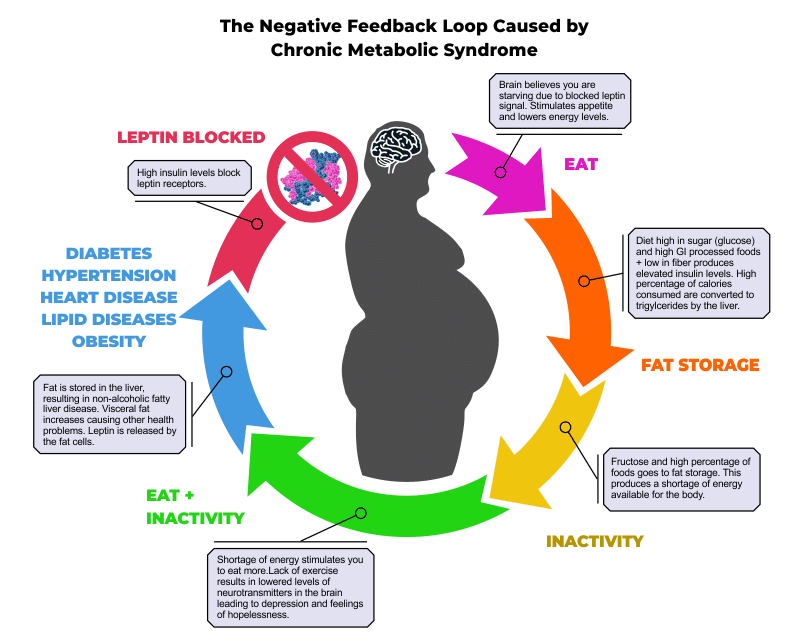
This graphic sums up the problem. The blocked leptin signal causes low energy and stimulates appetite, which keeps insulin levels high, which continues to block the leptin signal in an ever-fattening downward spiral.

Be the first to know about new Specials, and blog posts with valuable free information on skin care, beauty and wellness. Sign up below and you'll receive an email notice of new specials as well as new posts. You can unsubscribe at any time.


